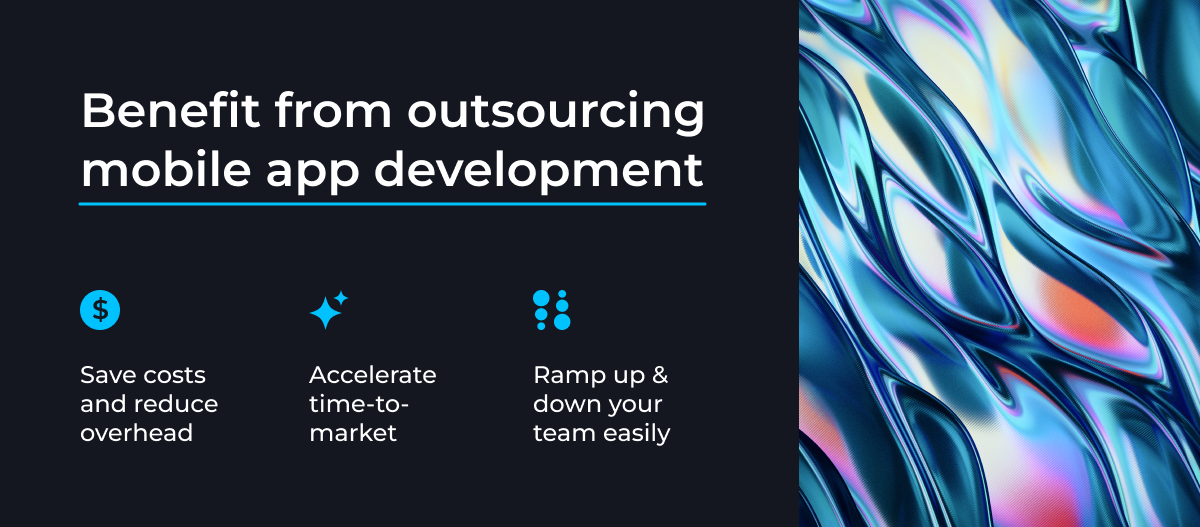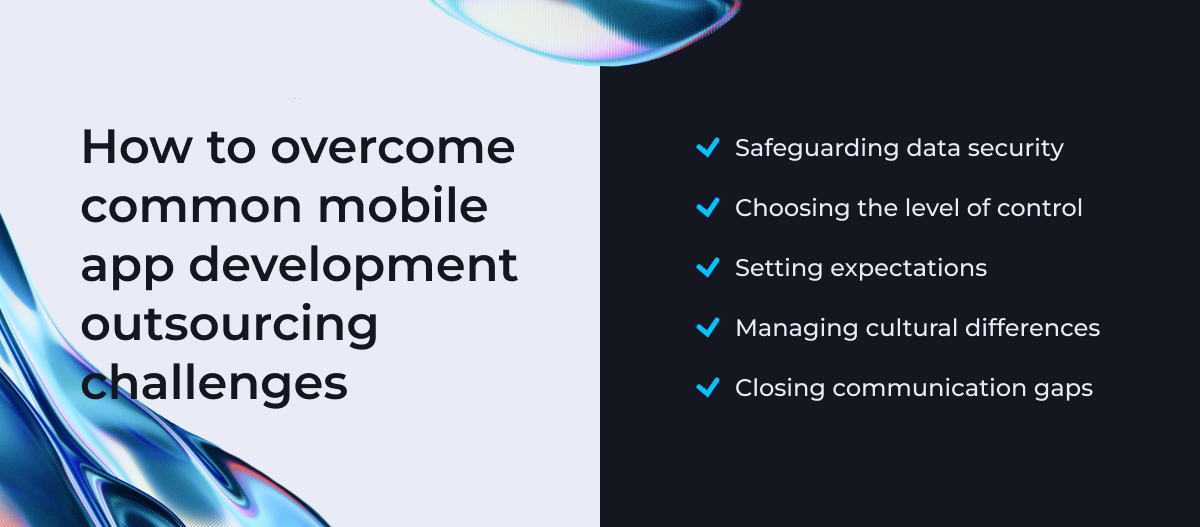No matter how confident you are in your app idea, developing a mobile application is a substantial undertaking. It demands significant effort and financial investment, which explains the widespread popularity of mobile app development outsourcing. When executed correctly, outsourcing enables you to address skill shortages in your region, tap into a readily available global talent pool, and achieve your goals without breaking the bank. The key is to do it right.
This guide is tailored to assist you in this endeavor. We will explore where you can outsource your mobile app development project, offer guidance on selecting the most suitable technology partner, and provide the best risk mitigation and cost optimization practices.
Whether you lead a small or large company, you might be wrestling with the decision of whether to embrace mobile app development outsourcing or maintain full in-house control. So let’s explore the reasons that could tilt the scales in favor of outsourcing.
- Lower costs. Access to a more affordable workforce is the foremost advantage of outsourcing mobile application development. You get to hire skilled and experienced tech specialists at a fraction of the cost of those in your country or region.
- Faster time to market. Mobile app development outsourcing companies maintain a readily available talent pool and well-established processes that help you hit the ground running. Before you know it, you’ll have an app ready to disrupt the market.
- A scalable development team. Working with an outsourcing company lets you grow and shrink your team as needed without the hassle of extensive hiring procedures or the stress of employee terminations.

As you delve deeper into outsourcing mobile development, it’s essential to consider the geographic aspects of your business strategy.
Geographically speaking, there are three outsourcing options: onshore, nearshore, and offshore. This section will focus on popular nearshore and offshore destinations in Eastern Europe and North America.
We’re also including the average salary of developers in each country, with the US average of $106,150 per year as the benchmark. (Disclaimer: Our statistics are based on average salaries from open sources at the time of writing. Actual salaries may vary depending on factors such as seniority level, technology stack, and more).
Ukraine: Mid-range costs for world-class talent
One of Europe’s leading IT outsourcing destinations, Ukraine is home to 289,000 information and communications technology (ICT) professionals and 467 tech companies. Fun fact: 20% of Fortune 500 companies, including Microsoft and Amazon, work with Ukraine-based vendors. GitLab, People.ai, Grammarly, and our very own ZoolaTech also all hail from Ukraine.
Here are more figures that show off Ukraine’s vibrant development scene:
- Pentalog ranks Ukrainian developers as the fourth best worldwide.
- Growing by 30% annually, Ukraine’s tech industry is now valued at $4 billion.
- During the 2020 pandemic, Ukraine-based startups got a record-high investment of $571 million.
- 80% of IT professionals in Ukraine speak intermediate to higher level English.
However, you may already be aware that since February 24, 2022, Ukraine has been facing military aggression. Indeed, you may wonder about the impact of the war on the state of the Ukrainian outsourcing industry.
What’s happening in the Ukrainian IT sector today serves as a testament to the resilience and dedication of Ukrainian development companies. The industry only slowed down for a couple of months, after which it got back to the pattern of exponential growth seen from 2014 to 2020. Twelve months after the onset of the war, it managed to earn $7.34 billion in IT service export earnings, a 5% increase from the previous year.
Revenue for the software market, in particular, is expected to reach $2.13 billion in 2023. It’s also projected to see an annual growth of 45.63% until it reaches a value of $13.95 billion by 2028.
Software developers in Ukraine earn an average yearly salary of $39,000.

Romania: Cheaper with a smaller talent pool
Romania boasts 198,440 ICT professionals. Their strength does not only come in numbers, with Pentalog ranking Romanians third in terms of the best developers in the world. The country also made it to the 2nd place globally in terms of software development services.
Unsurprisingly, Romania’s tech sector is raking in the big bucks, with an IT market size that exceeded 9 billion euros in 2022. Its IT services export was valued at 6 billion euros. The country’s IT market size is so large that it sees a deficit of 15,400 programmers.
Software developers in Romania earn an average yearly salary of $23,280.
The Czech Republic: Mid-range salaries and a strong startup vibe
Home to 210,447 ICT professionals, the Czech Republic is one of the world’s most attractive destinations for IT outsourcing. The country’s thriving IT sector is expected to earn a revenue of $2.2 billion by 2028. The ICT sector is already yielding an impressive output per employed worker of 117,542 euros.
Research from Startup Blink ranks the Czech startup ecosystem fourth in Eastern Europe in terms of total startup output per capita (or the startup performance relative to the country’s population). The scene gets support from top-notch accelerators, including JIC Starcube and StartupYard.
Software developers in the Czech Republic earn an average yearly salary of $39,228.
Poland: More developer choices at a higher price tag
Poland has a massive talent pool, employing as many as 486,000 ICT specialists. Yet this huge figure doesn’t compromise service quality, with Pentalog ranking Polish developers as the world’s seventh best. Poland also earned third place in the IT Competitiveness Index. The country’s tech sector is booming, with a software development industry valued at 8.8 billion euros.
Made up of approximately 3000 startups and 100 accelerators, Poland’s burgeoning startup scene is also worth mentioning. Startup Blink ranks the country’s startup ecosystem fifth in Eastern Europe, and Polish startups raised VC funding of 793 million euros in 2021 and 448 million euros in the first half of 2022.
Software developers in Poland earn an average yearly salary of $83,653.
Mexico: Affordable nearshoring for the US
The Mexican government supports the country’s tech sector with funding for startups and numerous tech parks that have become important innovation hubs. As a result, Mexican tech services are thriving and expect to see sustained growth. Here are some key projections:
- Software market revenue is expected to reach $3.98 billion in 2023
- The app market revenue is expected to see an annual growth of 8.81%
In 2022, Mexico had approximately 225 thousand software developers. And just as with the other countries on our list, they have impressive quality, with Pentalog putting the country in second place regarding the world’s best developers.
Software developers in Mexico earn an average yearly salary of $20,580.
The tech talent pool abroad is as massive as it is credible. However, outsourcing software development is not without its challenges. Let’s look at how you can prepare for them best.
Talent availability and cost savings are the biggest gains of app development outsourcing, but risks are naturally involved too. While a good technology partner will help you mitigate them, you can be proactive by following these good practices.

Safeguarding data security
Sensitive project data can be harder to safeguard when you take software development abroad. Take precautions by securing a stringent NDA. This attaches legal ramifications to data leaks, ensuring that your outsourcing partner follows strict security protocols.
Choosing the level of control
Outsourcing doesn’t have to mean handing over complete control of your project to your partner. If you choose, you can still effectively manage a team that’s located abroad — it’s just a matter of setting standard operating procedures.
Start by preparing a comprehensive service agreement that identifies a hierarchical structure, levels of authority, and decision-making procedures that you expect your partner company to follow. It can also help to outsource to countries with a similar time zone to widen your communication window.
Setting expectations
Even the most talented software development teams aren’t miracle-makers. To stay realistic, you need to devote time to careful planning. A good outsourcing company will have a consultation and discovery phase that checks the viability of your vision, objectives, and expected delivery dates.
Managing cultural differences
Work styles and urgency levels vary between cultures. You can work around these cultural differences by prioritizing open communication, clarifying software development needs and schedules, and setting clear expectations from the outset. Choosing an outsourcing provider that values soft skills as much as technical skills will also give you a good start. As you shop around for the right technology partner, make sure you take the time to ask questions about their culture and values.
Closing communication gaps
Taking your development process abroad means working with teams who have a different first language. Fortunately, popular outsourcing countries prepare their developers with not just top-notch tech skills but also high English proficiency. This means you’ll likely end up working with tech specialists who have no problem communicating with English speakers.
The final and most obvious best practice is taking time to choose the right partner. How can you make sure you get it right?
Your choice of technology partner can make or break your project. To ensure you make the right choice, carefully consider the following criteria.
Study company’s portfolio and technology stack
Begin your evaluation by thoroughly examining the technology partner’s portfolio and technology stack. Take a closer look at their track record: have they successfully delivered complex mobile apps in the past? Have they developed solutions within your specific industry?
Explore client reviews and ratings on B2B platforms like Clutch, G2, or GoodFirms, and similar to gain insights into their expertise and reliability. Hearing from previous clients can provide the necessary perspective when deciding whom to trust with your project. (See what ZoolaTech clients think of us here.)
Additionally, consider exploring alternative sources to evaluate app development vendors. Many outsourcing companies maintain tech blogs and contribute expert articles to magazines and tech communities, which can lead you to suitable candidates. You can also review their work on design-oriented websites such as Behance or Dribbble.
Be cautious with jacks-of-all-trades
While a software company may boast that it can handle everything and is experienced in nearly every technology, it’s essential to exercise caution. While this claim could be valid, it’s more likely that they may not accurately assess their capabilities or might be seeking to expand their portfolio at any cost. To gauge their competence, browse through the case studies available on the company’s website. Look for evidence of success with clients whose needs align with yours.
Evaluate the provider’s approach
The right questions to think over in this context are:
- Does the proposed approach of your candidate align with your project management expectations?
- Are they committed to delivering a complete product with all the features you require, or do they intend to deliver in stages, involving you in the iterative process?
A reputable provider should advise you to start with minimal app functionality, prioritizing core features. As you and your partner gain a clearer picture of the cost associated with each app development component, you can proceed according to your project’s capacities and priorities.
Consider team structure and expertise
Depending on the stage of your mobile app development project, you may require various specialists on your team. Assess whether the vendor can provide the additional expertise, considering aspects such as:
- Graphic design and user interface design.
- Quality assurance and testing.
- Brand identity and marketing strategy.
- Risk assessment and goal setting.
- Project management and issue resolution.
Based on your specific needs, you may require roles such as QA specialists, UI/UX designers, business analysts (BA), project managers (PM), in addition to software engineers and architects.
Consider cost-to-value ratio
In the realm of mobile app development, you’ll often encounter the concept of the “value triangle,” where you must choose two out of three attributes: quality, price, and speed. Some vendors may offer affordability but sacrifice quality, while others may boast well-established processes and a talented team but at a higher cost.
However, a reliable mobile app development partner ensures you don’t compromise on quality, time-to-market, or cost-effectiveness. It can be achieved by leveraging experienced team members, finding contractors in strategic outsourcing locations, as discussed above, and starting with the minimum required features. This combination guarantees a high-quality app within budget and deadlines.
Once you’ve chosen a technology partner, it’s time to consider who goes on your team.
Your development team is the life force behind your project, so you must ensure you have a strong one. Let’s see how to ensure that.
Give your team time to settle in
Let’s be real, no matter how skilled your outsourcing team is, they won’t instantly grasp all the ins and outs of your company or project right off the bat. Whether your project is just starting or already in progress, take the time to give your new team members a solid introduction to the project and your development process. It’s crucial to let them get comfortable. Discuss reasonable timelines and expectations adjusted based on project complexity without overdoing the micromanagement.
Use agile development methodologies
Divide the project into separate development phases such as MVP, full-scale product, and version iterations, then decide on the best project management framework to use throughout the development process. For example, you can start using Kanban and slowly switch to Scrum as the project becomes more complex.
Encourage constant feedback
Establishing a feedback loop has a dual purpose: it fosters continuous improvement and enables prompt issue resolution. Through regular feedback sessions and open communication channels, you can enhance team performance, streamline processes, and swiftly address any challenges that may arise. This proactive approach contributes to the overall success of your mobile app development project.
Balance culture fit with tech competence
Our final words of advice? Don’t just expect your development team to figure out your company culture or way of doing things. Go out of your way to provide proper orientation, keep communication lines open, and encourage team collaboration.
Offshore development center
This cooperation model is a perfect fit if you want to have a part of your mobile product development performed by smart, self-sufficient, and highly motivated offshore teams. With focus on long-lasting cost-efficiency.
We’ll help you build strong tech teams fast and integrate them seamlessly into your delivery process. You will enjoy full transparency, and painless scalability, and flexibility.

Team extension
Choose the team extension model if you need to augment your in-house team with strong software engineers fast and easily. This model will help you to scale up and down easily as well as save costs and time by avoiding recruitment, HR, and admin overhead.

Managed delivery
If you have a great idea and want to have your product delivered by a team rooting for your product success – managed delivery is a perfect choice. From an idea to a full-fledged solution – we’ll have you covered each step of the way, helping to mitigate risks, reduce costs, and take future-proof decisions.

Mobile app development outsourcing is the answer if you want to access top talent and development processes without breaking the bank. It can be scary, but it doesn’t have to be when you have the preparation and advice in our guide under your belt.
And some more good news? You won’t even have to look too far overseas to find the right team. Whether you’re in the US or this side of the Atlantic, the best outsourcing opportunities are in your neighboring countries. From Mexico to Ukraine, you’ll find just the nearshoring destination for your development needs.
- ZoolaTech is a global software development company with offices in Ukraine, Poland, Mexico, Turkey, and the USA.
- Flexibility of cooperation models: ODC, Team Extension, Managed Delivery, or mixed
- 96% – client retention rate
- 60% – senior software engineers
- When starting cooperation, we provide you with a team of experts with 5+ years of experience
- Proven expertise in iOS, Android, and Cross-platform development.
- Trusted by Fortune 500 companies.
